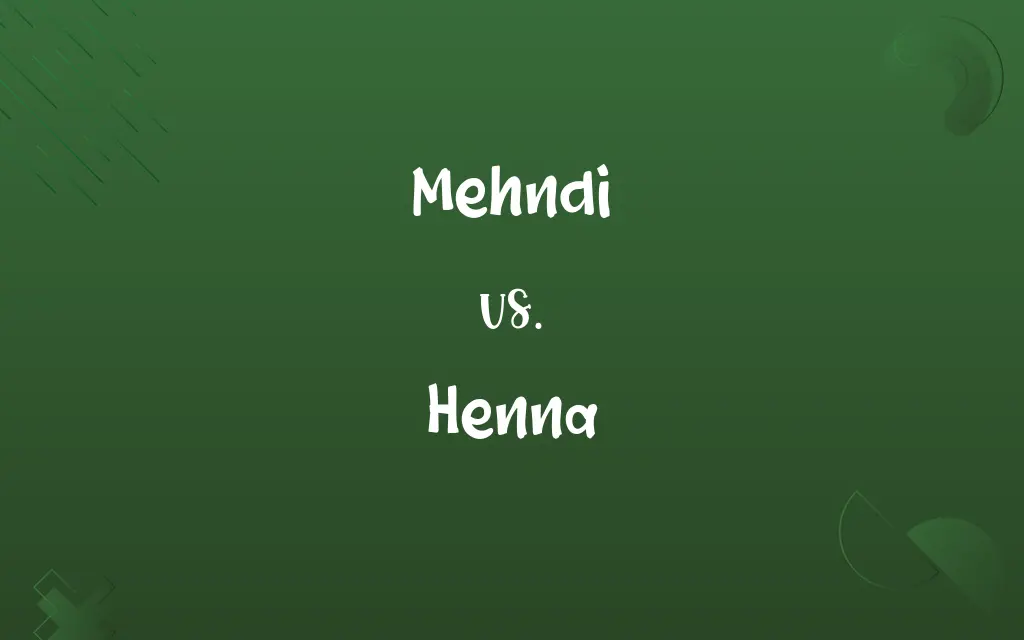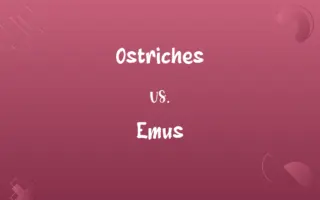Mehndi vs. Henna: Know the Difference

By Shumaila Saeed || Published on February 25, 2024
Mehndi refers to the art of applying designs on the skin using a paste made from henna leaves, while henna is the natural dye extracted from these leaves.

Key Differences
Mehndi is the cultural practice of creating intricate designs on the skin, commonly used in various ceremonies. Henna, on the other hand, is the natural substance derived from the Lawsonia inermis plant used in this art.
Shumaila Saeed
Feb 25, 2024
Mehndi is recognized for its significance in traditional ceremonies in South Asian and Middle Eastern cultures. Henna is valued for its cooling properties and natural dyeing ability, not just for body art but also for hair coloring.
Shumaila Saeed
Feb 25, 2024
In Mehndi, the focus is on the patterns and symbolism of the designs, often carrying cultural and personal meanings. Henna is known for its distinct reddish-brown color, which stains the skin and fades over time.
Shumaila Saeed
Feb 25, 2024
Mehndi is an integral part of wedding ceremonies, particularly in Hindu and Muslim traditions. Henna, as a natural dye, has also been historically used for medicinal purposes, owing to its antifungal and antibacterial properties.
Shumaila Saeed
Feb 25, 2024
Mehndi art varies in style and complexity, from simple dots to elaborate floral and geometric patterns. Henna paste, when applied, undergoes a drying process, after which it is removed to reveal the stained design.
Shumaila Saeed
Feb 25, 2024
ADVERTISEMENT
Comparison Chart
Definition
Art form of applying designs on the skin
Natural dye made from Lawsonia inermis
Shumaila Saeed
Feb 25, 2024
Cultural Significance
Used in ceremonies and rituals
Used for its dyeing and cooling properties
Shumaila Saeed
Feb 25, 2024
Application
Applied in intricate patterns
Used as a paste to stain skin or hair
Shumaila Saeed
Feb 25, 2024
Color
Associated with the design's aesthetic
Known for its reddish-brown dye
Shumaila Saeed
Feb 25, 2024
Usage in Ceremonies
Central in weddings and festivals
Also used but more for its natural properties
Shumaila Saeed
Feb 25, 2024
ADVERTISEMENT
Historical Aspect
Symbolic in various cultures
Used historically for medicinal purposes
Shumaila Saeed
Feb 25, 2024
Mehndi and Henna Definitions
Mehndi
A traditional art of applying intricate designs on the skin.
She wore beautiful mehndi on her hands for the wedding.
Shumaila Saeed
Jan 17, 2024
Henna
A natural dye obtained from the henna plant used for coloring skin and hair.
She used henna to achieve a rich, reddish-brown hair color.
Shumaila Saeed
Jan 17, 2024
Mehndi
Mehndi refers to the temporary body art practiced in various cultures.
During the festival, everyone admired her mehndi designs.
Shumaila Saeed
Jan 17, 2024
Henna
A natural substance used for its cooling properties and as a skin conditioner.
He applied henna to his scalp for its cooling effect.
Shumaila Saeed
Jan 17, 2024
ADVERTISEMENT
Mehndi
A ceremonial art form involving the application of henna paste in patterns.
The bride's mehndi was detailed and symbolic.
Shumaila Saeed
Jan 17, 2024
Henna
A traditional dye used in various cultures for cosmetic and medicinal purposes.
For centuries, henna has been used for its natural dye and healing qualities.
Shumaila Saeed
Jan 17, 2024
Mehndi
Mehndi encompasses the cultural practice of skin decoration.
For the Diwali celebration, she chose an elaborate mehndi design.
Shumaila Saeed
Jan 17, 2024
Henna
Henna refers to the Lawsonia inermis plant, known for its dyeing properties.
The henna plant is cultivated for its leaves, which are ground into powder.
Shumaila Saeed
Jan 17, 2024
Mehndi
A form of body art where designs are created on the skin using henna.
Her mehndi session took hours, resulting in stunning patterns.
Shumaila Saeed
Jan 17, 2024
Henna
Henna is the paste made from ground henna leaves, used for body art.
The henna paste left a beautiful stain on her hands.
Shumaila Saeed
Jan 17, 2024
Mehndi
The application of henna paste in intricate designs to decorate the body, often for wedding celebrations and other festive occasions in South Asia, the Middle East, and North Africa.
Shumaila Saeed
Jan 15, 2024
Henna
A tree or shrub (Lawsonia inermis) of the Middle East, having fragrant white or reddish flowers.
Shumaila Saeed
Jan 15, 2024
Henna
A reddish-brown dyestuff prepared from the dried and ground leaves of this plant, used especially in South and Southwest Asia and North Africa to color leather and fabrics, to dye hair, and to decorate the skin.
Shumaila Saeed
Jan 15, 2024
Henna
(countable) A shrub, Lawsonia inermis, having fragrant reddish flowers
Shumaila Saeed
Jan 15, 2024
Henna
A reddish plant substance, prepared from the dried leaves of this plant, used for temporary tattoos and hair coloring. Hair colorings range from bright red to earth brown to near black.
Shumaila Saeed
Jan 15, 2024
Henna
A thorny tree or shrub of the genus Lawsonia (Lawsonia alba). The fragrant white blossoms are used by the Buddhists in religious ceremonies. The powdered leaves furnish a red coloring matter used in the East to stain the nails and fingers, the manes of horses, etc.
Shumaila Saeed
Jan 15, 2024
Henna
The leaves of the henna plant, or a preparation or dyestuff made from them.
Shumaila Saeed
Jan 15, 2024
Repeatedly Asked Queries
How long does mehndi last on the skin?
Typically, it lasts 1-2 weeks, depending on care.
Shumaila Saeed
Feb 25, 2024
Is mehndi culturally significant?
Yes, particularly in South Asian and Middle Eastern cultures.
Shumaila Saeed
Feb 25, 2024
What is henna made of?
Made from the powdered leaves of the Lawsonia inermis plant.
Shumaila Saeed
Feb 25, 2024
Does henna have health benefits?
Yes, it has cooling properties and can have antifungal effects.
Shumaila Saeed
Feb 25, 2024
Are there different colors of henna?
Natural henna stains reddish-brown; other colors are not pure henna.
Shumaila Saeed
Feb 25, 2024
Is mehndi safe for all skin types?
Generally, yes, but patch tests are recommended for those with sensitive skin.
Shumaila Saeed
Feb 25, 2024
How is mehndi applied?
Using a cone or brush to create designs with henna paste.
Shumaila Saeed
Feb 25, 2024
Can henna cause allergic reactions?
Pure henna is rarely allergenic, but additives in some mixes can cause reactions.
Shumaila Saeed
Feb 25, 2024
What events are associated with mehndi?
Commonly used in weddings, religious festivals, and celebrations.
Shumaila Saeed
Feb 25, 2024
What's the difference between black henna and natural henna?
Black henna contains additives and chemicals, while natural henna is pure.
Shumaila Saeed
Feb 25, 2024
Can mehndi be applied to any part of the body?
Typically, it's applied to hands and feet, but can be used elsewhere.
Shumaila Saeed
Feb 25, 2024
Does the shade of henna vary?
Yes, depending on the mixture and application time.
Shumaila Saeed
Feb 25, 2024
How long should henna be left on the skin?
Usually a few hours, for a darker stain.
Shumaila Saeed
Feb 25, 2024
How is henna prepared for use?
By mixing the powdered leaves with liquids like water or lemon juice.
Shumaila Saeed
Feb 25, 2024
How do you remove mehndi faster?
Exfoliation and frequent washing can fade it more quickly.
Shumaila Saeed
Feb 25, 2024
Can mehndi designs be customized?
Yes, designs can be tailored to personal preference.
Shumaila Saeed
Feb 25, 2024
Is henna used in all cultures?
While widespread, its use varies among different cultural groups.
Shumaila Saeed
Feb 25, 2024
Are there symbolic meanings in mehndi designs?
Yes, many designs carry cultural or personal symbolism.
Shumaila Saeed
Feb 25, 2024
Share this page
Link for your blog / website
HTML
Link to share via messenger
About Author
Written by
Shumaila SaeedShumaila Saeed, an expert content creator with 6 years of experience, specializes in distilling complex topics into easily digestible comparisons, shining a light on the nuances that both inform and educate readers with clarity and accuracy.









































































